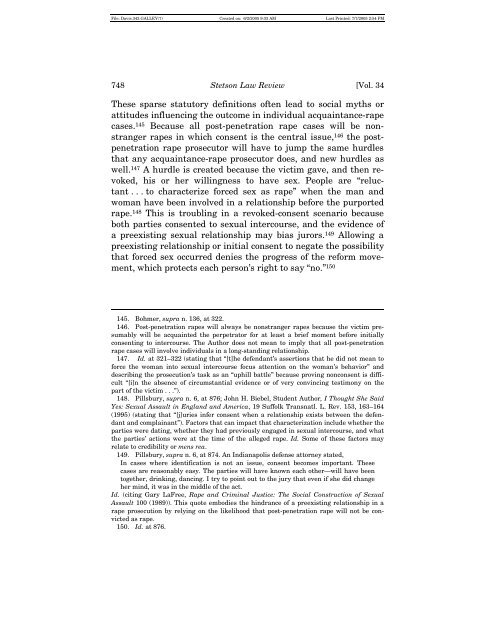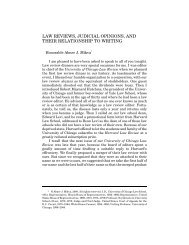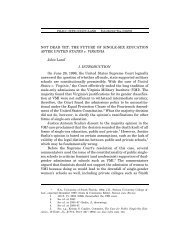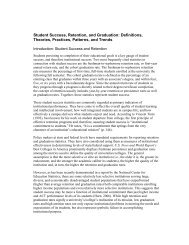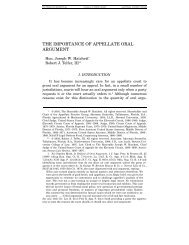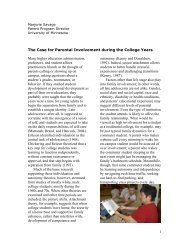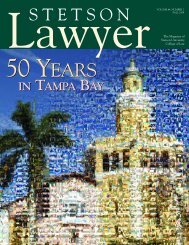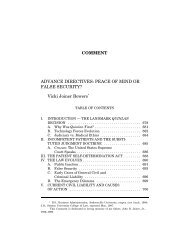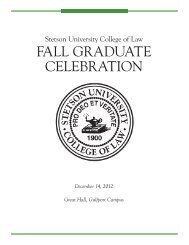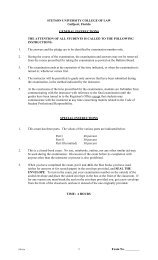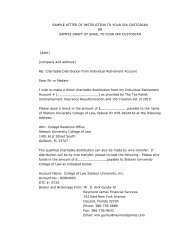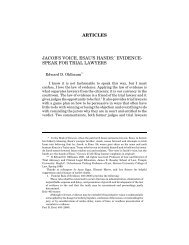the evolution of post-penetration rape law - Stetson University ...
the evolution of post-penetration rape law - Stetson University ...
the evolution of post-penetration rape law - Stetson University ...
You also want an ePaper? Increase the reach of your titles
YUMPU automatically turns print PDFs into web optimized ePapers that Google loves.
File: Davis.343.GALLEY(7) Created on: 6/2/2005 9:33 AM Last Printed: 7/7/2005 2:54 PM748 <strong>Stetson</strong> Law Review [Vol. 34These sparse statutory definitions <strong>of</strong>ten lead to social myths orattitudes influencing <strong>the</strong> outcome in individual acquaintance-<strong>rape</strong>cases. 145 Because all <strong>post</strong>-<strong>penetration</strong> <strong>rape</strong> cases will be nonstranger<strong>rape</strong>s in which consent is <strong>the</strong> central issue, 146 <strong>the</strong> <strong>post</strong><strong>penetration</strong><strong>rape</strong> prosecutor will have to jump <strong>the</strong> same hurdlesthat any acquaintance-<strong>rape</strong> prosecutor does, and new hurdles aswell. 147 A hurdle is created because <strong>the</strong> victim gave, and <strong>the</strong>n revoked,his or her willingness to have sex. People are “reluctant. . . to characterize forced sex as <strong>rape</strong>” when <strong>the</strong> man andwoman have been involved in a relationship before <strong>the</strong> purported<strong>rape</strong>. 148 This is troubling in a revoked-consent scenario becauseboth parties consented to sexual intercourse, and <strong>the</strong> evidence <strong>of</strong>a preexisting sexual relationship may bias jurors. 149 Allowing apreexisting relationship or initial consent to negate <strong>the</strong> possibilitythat forced sex occurred denies <strong>the</strong> progress <strong>of</strong> <strong>the</strong> reform movement,which protects each person’s right to say “no.” 150145. Bohmer, supra n. 136, at 322.146. Post-<strong>penetration</strong> <strong>rape</strong>s will always be nonstranger <strong>rape</strong>s because <strong>the</strong> victim presumablywill be acquainted <strong>the</strong> perpetrator for at least a brief moment before initiallyconsenting to intercourse. The Author does not mean to imply that all <strong>post</strong>-<strong>penetration</strong><strong>rape</strong> cases will involve individuals in a long-standing relationship.147. Id. at 321–322 (stating that “[t]he defendant’s assertions that he did not mean t<strong>of</strong>orce <strong>the</strong> woman into sexual intercourse focus attention on <strong>the</strong> woman’s behavior” anddescribing <strong>the</strong> prosecution’s task as an “uphill battle” because proving nonconsent is difficult“[i]n <strong>the</strong> absence <strong>of</strong> circumstantial evidence or <strong>of</strong> very convincing testimony on <strong>the</strong>part <strong>of</strong> <strong>the</strong> victim . . .”).148. Pillsbury, supra n. 6, at 876; John H. Biebel, Student Author, I Thought She SaidYes: Sexual Assault in England and America, 19 Suffolk Transnatl. L. Rev. 153, 163–164(1995) (stating that “[j]uries infer consent when a relationship exists between <strong>the</strong> defendantand complainant”). Factors that can impact that characterization include whe<strong>the</strong>r <strong>the</strong>parties were dating, whe<strong>the</strong>r <strong>the</strong>y had previously engaged in sexual intercourse, and what<strong>the</strong> parties’ actions were at <strong>the</strong> time <strong>of</strong> <strong>the</strong> alleged <strong>rape</strong>. Id. Some <strong>of</strong> <strong>the</strong>se factors mayrelate to credibility or mens rea.149. Pillsbury, supra n. 6, at 874. An Indianapolis defense attorney stated,In cases where identification is not an issue, consent becomes important. Thesecases are reasonably easy. The parties will have known each o<strong>the</strong>r—will have beentoge<strong>the</strong>r, drinking, dancing. I try to point out to <strong>the</strong> jury that even if she did changeher mind, it was in <strong>the</strong> middle <strong>of</strong> <strong>the</strong> act.Id. (citing Gary LaFree, Rape and Criminal Justice: The Social Construction <strong>of</strong> SexualAssault 100 (1989)). This quote embodies <strong>the</strong> hindrance <strong>of</strong> a preexisting relationship in a<strong>rape</strong> prosecution by relying on <strong>the</strong> likelihood that <strong>post</strong>-<strong>penetration</strong> <strong>rape</strong> will not be convictedas <strong>rape</strong>.150. Id. at 876.


